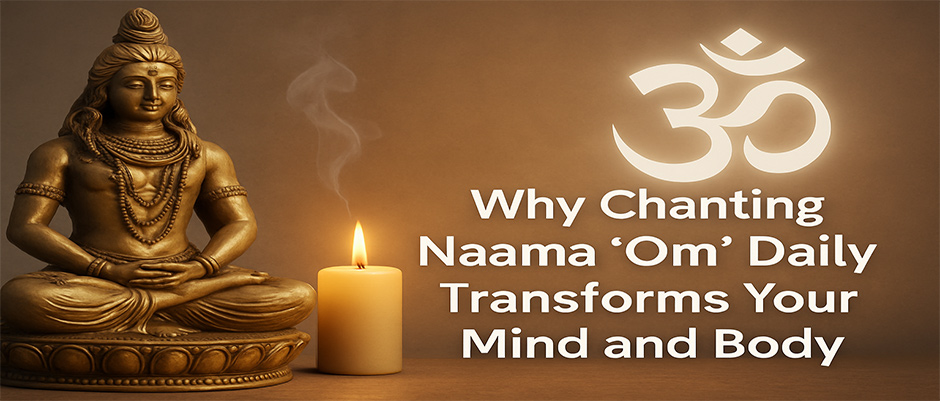
Why Chanting Naama 'Om' Daily Transforms Your Mind and Body
Why Chanting Naama 'Om' Daily Transforms Your Mind and Body
Introduction: The Sacred Power of Om
Among all the sacred sounds in spiritual traditions, 'Om' (or Aum) stands alone in its profound simplicity and universal resonance. Revered as the primordial sound of creation, Om is more than a chant—it's a vibration that connects the individual self to the cosmic whole. Across Hinduism, Buddhism, Jainism, and even yogic sciences, chanting Naama 'Om' daily is known to transform one's mind, body, and spirit.
But how and why does this one-syllable sound hold such power? Let’s dive into its meaning, science, and the transformative effects it offers with consistent daily practice.
What Is 'Naama' and Why Is 'Om' the Ultimate Naama?
Naama means “name,” especially in the context of the divine name—the sacred name of God. In many devotional paths (Bhakti Yoga, Nama Japa), chanting the name of the Divine is seen as the purest and most accessible spiritual practice.
Among all Naamas, ‘Om’ is the root, the origin, the universal name from which all other divine names arise. It is:
• The sound of creation (Shabda Brahman)
• The essence of the Vedas
• A representation of Brahman (the Supreme Consciousness)
Etymology and Symbolism of Om
The sound Om consists of three parts:
• A – Creation, waking state
• U – Preservation, dreaming state
• M – Destruction, deep sleep state
Together, they represent the entire cycle of life and states of consciousness. The silence that follows Om is just as important—it signifies the absolute, infinite state (Turiya).
The visual symbol of Om also carries rich meaning, representing waking, dream, deep sleep, and the infinite beyond.
The Science of Sound: Why 'Om' Is No Ordinary Syllable
Om as a Primordial Sound
Ancient seers described Om as the sound of the universe—the first vibration that led to all creation. Interestingly, modern cosmologists have noted that the residual sound of the Big Bang closely resembles the deep hum of Om.
Frequency and Resonance with the Human Body
Scientific studies show that chanting Om:
• Generates a frequency around 432 Hz, closely aligned with natural frequencies of Earth and the human body
• Creates a vibrational resonance in the nasal, skull, and chest cavities, producing a calming and harmonizing effect
• Activates the vagus nerve, a key player in parasympathetic relaxation
Effects of Chanting Om on the Mind
Reducing Mental Chatter
One of the most immediate effects of Om chanting is the reduction of mental noise. As the sound resonates, it draws awareness inward, slows down thought patterns, and soothes anxiety.
MRI and EEG scans have shown:
• Deactivation of the default mode network (responsible for self-referential thoughts)
• Activation of the prefrontal cortex, promoting clarity and mindfulness
Enhancing Mental Clarity and Awareness
With daily practice, Om helps develop:
• Sharper focus
• Improved memory
• Balanced emotional responses
It leads to a state of alpha brain wave activity, associated with creativity, calm, and relaxed alertness.
Effects of Chanting Om on the Body
Impact on the Nervous System
Om chanting:
• Triggers the parasympathetic nervous system
• Lowers heart rate and blood pressure
• Slows down respiration
The sound’s vibratory nature massages internal organs, especially in the chest and abdomen, and stimulates relaxation responses in the body.
Heart Rate, Breath, and Hormonal Regulation
Daily Om chanting has been shown to:
• Lower cortisol levels (stress hormone)
• Enhance heart rate variability (HRV), an indicator of cardiovascular health
• Improve overall endocrine function, helping balance hormones like serotonin and dopamine
Spiritual Benefits of Daily Om Chanting
Awakening the Inner Self
Om is considered a gateway to the soul. Repetition brings awareness inward, helping you:
• Detach from ego-driven thoughts
• Experience presence and stillness
• Connect with your true self
Alignment with Universal Energy
The sound of Om acts like a spiritual tuning fork, aligning your consciousness with the universe. Over time, this builds:
• Greater compassion
• Inner peace
• A sense of divine oneness
How to Start Chanting Om Daily
Best Times to Chant Om
• Brahma Muhurta (1.5 hrs before sunrise) – Most powerful and energetically clean time
• Sunset or before bed – Releases tension and prepares you for inner rest
How Many Times Should You Chant?
• Beginners: 11 or 21 times daily
• Regular practice: 108 times using a mala
• Advanced: Multiple rounds or full sessions of 15–30 minutes
Using Breath and Posture for Deeper Effect
• Sit upright in Sukhasana or Padmasana
• Inhale deeply and chant Om in one full breath
• Let the “Mmmm” sound last twice as long as the “O” part
• Feel the vibration travel through your skull, throat, and chest
